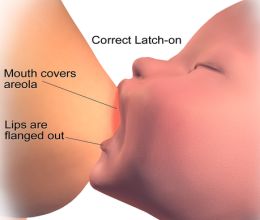The Correct Latch-On
 It is not uncommon for a mum new to breastfeeding to encounter problems especially during the first few days or even weeks after delivery. It is therefore important to recognize when you need help and to get it at the earliest signs of problems. Most hospitals will have a lactation consultant who may conduct short sessions on the basics of breastfeeding and the potential pitfalls to avoid.
It is not uncommon for a mum new to breastfeeding to encounter problems especially during the first few days or even weeks after delivery. It is therefore important to recognize when you need help and to get it at the earliest signs of problems. Most hospitals will have a lactation consultant who may conduct short sessions on the basics of breastfeeding and the potential pitfalls to avoid.
Ensuring a Proper Latch-on
Some newborns latch on easily but others may need a little help. A proper latch on is key to successful breastfeeding. It is important to ensure that your baby is feeding optimally and emptying the breast well as this will have an impact on establishing the milk supply. If a baby is latched on properly, you will also avoid problems of sore and/or bleeding nipples which can seriously affect the success of your breastfeeding.
The first step to a good latch on is getting baby to open her mouth wide. You can do this by brushing baby's lips with your nipple to encourage her to open her mouth. Do not be in a hurry, the last thing you want is to offer your breast to baby when her mouth is not open wide enough and to have her clamp down on your nipple and start chewing on it. When baby's mouth is wide open, quickly pull her onto the breast by bringing her towards you with the arm that is holding her (and not you moving toward her).
The baby should take in almost the entire areola into her mouth and not just the nipple. She should also be able to breathe easily without you having to push your breast away from her nose. The baby should appear relaxed, suckling deeply and if you observe closely, will notice her swallowing after a few sucks. The swallowing is less obvious during the early days when she is just drinking colostrum which are in small amounts but will become more obvious when the milk has come in. While your baby is suckling, it should involve the use of her lower jaw causing her ears to "wiggle". This indicates that she is suckling well and efficiently. If she is restless and fidgety, she is probably not latching on well. She may stop after the initial few minutes of feeding when milk is flowing at its fastest or pause to catch her breath and then start suckling again. This is perfectly normal. You also should not see much milk leaking out from the corners of your baby's milk nor hear any clicking sounds.
When she is done, she should fall away from your breast on her own. Offer her the other breast. If she refuses it, it could just mean that she has had enough. If so, remember to offer that breast first the next time she wants to feed.
If you feel pain, it is a sign that your baby is not latched on properly, in which case, you should take your infant off the breast immediately by putting your finger in your baby's mouth and break the seal between her tongue and the roof of her mouth - and try again. If you still feel pain, seek help from the lactation consultant immediately. You should not continue to let your baby feed incorrectly or you are likely to develop painful, damaged and even bleeding nipples. A baby who is not feeding properly will not empty the breast well which will in turn affect the supply of milk.
Breastmilk is ideal for your baby. Breastfeeding is also a great way of bonding with your baby and is extremely comforting for the baby, so even if you don't get it right from the word go, you would do well to try and try again. Once you and your baby gets the hang of it, you will find that she will feed effortlessly and properly almost every time.
Image by: Blausen.com staff. "Blausen gallery 2014". Wikiversity Journal of Medicine.
Further Reading
The article above is meant to provide general information and does not replace a doctor's consultation.
Please see your doctor for professional advice.
